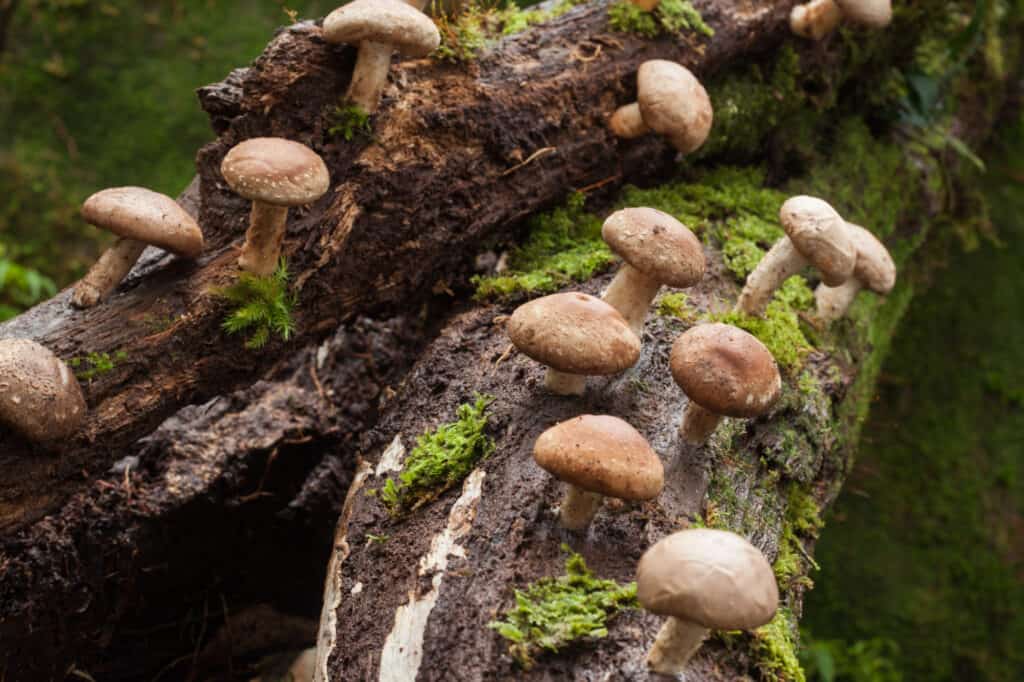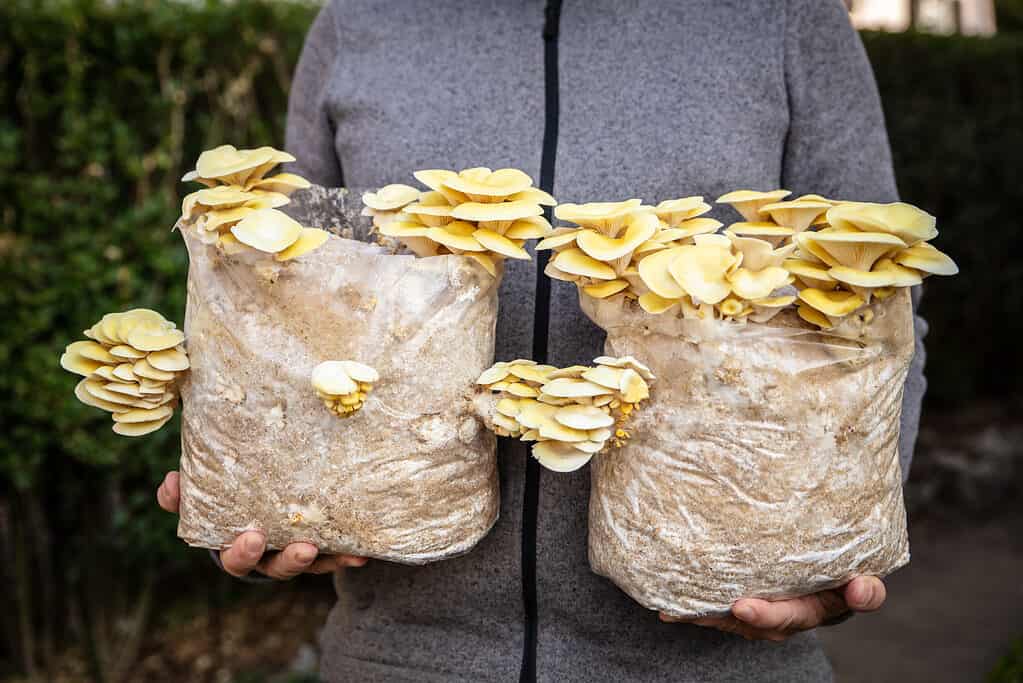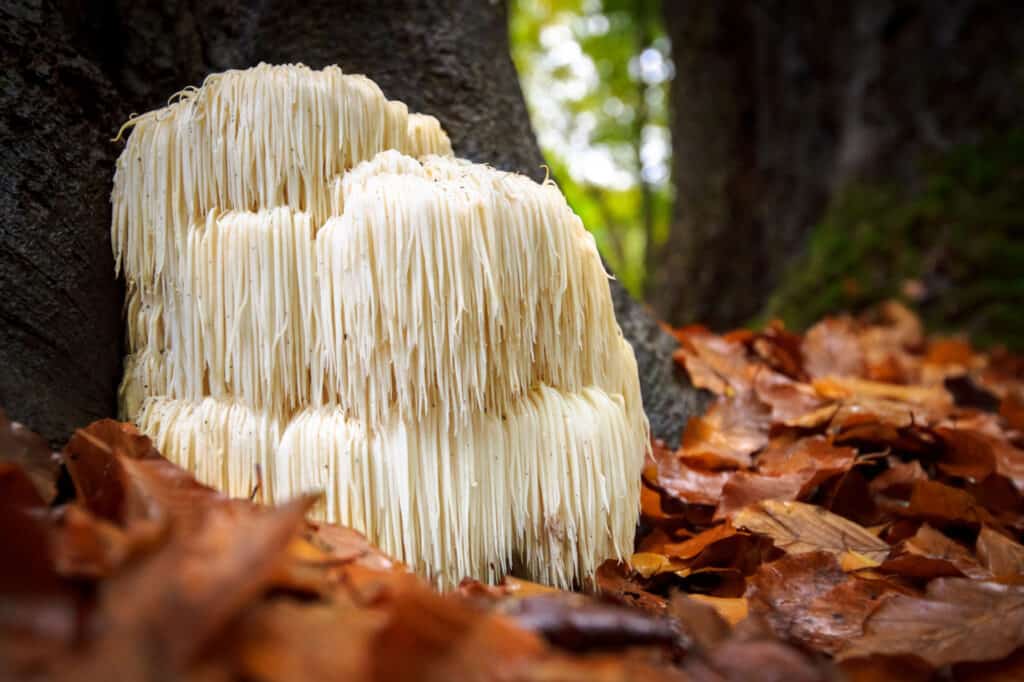If you’re interested in cultivating or foraging for mushrooms, you may be wondering just how long does it take mushrooms to grow?
Well, there’s no hard and fast answer to this question as different species have different growing times. But, we can provide some background on the process of mushroom formation including time periods.
So, in this guide, we’ll broadly cover how mushrooms form, and then provide some examples of average growing times of some popular cultivated mushroom species.
Read on to learn more.
How and Why Do Mushrooms Form?

Some polypores can last for years.
©Sun Shock/Shutterstock.com
Before we get into various growing times for a range of mushroom species, we’ll talk about how and why mushrooms form. In this guide, we’ll define mushrooms as the macroscopic, fleshy, spore-bearing fruiting bodies of fungi within the Dikarya subkingdom.
The mushroom represents only part of the structure of a fungus, with the majority of the organism existing underground as mycelium, the vegetative, branching, web-like body of the fungus that absorbs nutrients and is responsible for the formation of a mushroom. The mushroom exists to bear and disperse spores, a very small percentage of which will form more mycelium, which will in turn produce more mushrooms to continue the cycle.
What Triggers Mycelium to Form Mushrooms?
Certain environmental requirements need to be met, which can include temperature, light, C02 and oxygen levels, soil chemistry, and moisture levels, to trigger mycelium to begin producing mushrooms. Once these conditions are met, which are species-specific, mushrooms can begin forming.
Some species release their spores all at once, while others disperse them in waves. Once (if applicable) the final waves of spores are released, the life cycle of the mushroom is complete while the mycelium lives on.
So, How Long Does it Take Mushrooms to Grow?

Inky cap mushrooms,
Coprinus comatus©Mike Workman/Shutterstock.com
If we’re talking about the full life cycle of the mushroom, the answer could be a day, days, weeks, months, or even years. Some mushrooms, like inky caps such as the shaggy mane (Coprinus comatus), only appear for a day or two before succumbing to decay or autodigestion. Others, such as the turkey tail (Trametes versicolor) have fruiting bodies that can last for months if not years. And even tougher, extremely resilient polypores like the tinder conk (Fomes fomentarius) can produce mushrooms that can last for up to 30 years.
Typically, mushrooms that release their spores all at once, such as puffball mushrooms, tend to have shorter life cycles.
What About Common Cultivated Mushrooms?
Below, we’ll cover the average growing times of a few commonly cultivated edible mushroom species.
How Long Does it Take Mushrooms to Grow: Shiitake Mushrooms

Most shitake mushrooms being cultivated on logs.
©puttography/Shutterstock.com
The shiitake mushroom (Lentinula edodes), is one of the most cultivated mushroom species in the world. This species is known for having a rather slow incubation time than other commonly cultivated species.
If you’re growing indoors via hardwood sawdust blocks, you can expect the mycelium to take about 8-12 weeks to fully colonize the substrate. At this point, the grower can trigger the conditions for fruiting and the mycelium can start to produce the mushrooms. The first stage of fruiting is often called “pinning”. At this stage, the mushrooms can look like little pinheads at this phase of development.
If you’re growing outdoors on logs, the incubation period is much, much longer. This can take 6 months to two years depending on the diameter of the log and a number of other conditions. However, once the mushrooms begin to form, they usually mature as fast as indoor-grown specimens. Pinning to maturity usually takes 7-10 days for shiitakes. You will want to harvest them when the caps are opened 60-80%.
How Long Does it Take Mushrooms to Grow: the Common Oyster Mushroom

, growing mushrooms at home.
©Miriam Doerr Martin Frommherz/Shutterstock.com
The common oyster mushroom (Pleurotus ostreatus) is also one of the world’s most cultivated mushroom species. Compared to shiitakes, oyster mushrooms colonize substrates and are ready to fruit in much less time. For Pleurotus ostreatus, you can expect an incubation period of just 10-21 days depending on the substrate used.
From pinning, this fast-growing species should produce harvestable fruits in 3-5 days.
How Long Does it Take Mushrooms to Grow: Lion’s Mane Mushrooms

Lion’s mane growing in the wild.
©Fotografiecor.nl/Shutterstock.com
For our last example, we’ll look at the fruiting time of the lion’s mane mushroom (Hericium erinaceus). This mushroom is currently heavily researched for its possible medicinal use in neurodegenerative and inflammatory gastrointestinal diseases.
Typically, the incubation time for indoor-cultivated Hericium erinaceus is 4-6 weeks. Once pinning starts, lion’s mane mushrooms should be ready in 5-7 days. You’ll want to harvest this unique mushroom when the “teeth” are forming. The key is to harvest while the fruiting body is still all white, as opposed to when it starts to turn golden-brown.
The photo featured at the top of this post is © iStock.com/lenoo
The information presented on or through the Website is made available solely for general informational purposes. We do not warrant the accuracy, completeness, or usefulness of this information. Any reliance you place on such information is strictly at your own risk. We disclaim all liability and responsibility arising from any reliance placed on such materials by you or any other visitor to the Website, or by anyone who may be informed of any of its contents. None of the statements or claims on the Website should be taken as medical advice, health advice, or as confirmation that a plant, fungus, or other item is safe for consumption or will provide any health benefits. Anyone considering the health benefits of particular plant, fungus, or other item should first consult with a doctor or other medical professional. The statements made within this Website have not been evaluated by the Food and Drug Administration. These statements are not intended to diagnose, treat, cure or prevent any disease.
Thank you for reading! Have some feedback for us? Contact the AZ Animals editorial team.







